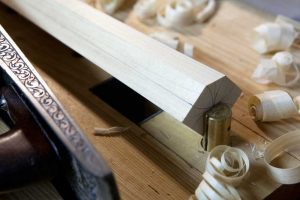We may receive a commission when you use our affiliate links. However, this does not impact our recommendations.
When I moved from the Deep South to the Midwest, it took me awhile to realize that the word “interesting” is not always a good thing.
For example, Sno-Balls have an interesting aftertaste.
Another example: Woodworkers have a lot of interesting ways of laying out an equilateral octagon.
Why is this important? Hand-tool woodworkers, turners and chairmakers use octagons all the time to make tool handles, to make turnings easier to rough out and to make simple chair legs.
I’ve seen people try to lay them out by eye. This works, but it takes patience and extreme sobriety.
At the other end of the spectrum are people who use the Pythagorean Theorem to calculate each side of the polygon and then lay it out with a ruler.
And I’ve seen people step it off with dividers using trial and error.
The easiest way I’ve found is related to the Pythagorean Theorem, but it uses only one setting of your compass to short-circuit the entire calculation process. It turns a square into a perfect equilateral octagon in seconds.
I use this trick all the time, especially when making tapered octagons, like the legs of a stool I’m building for a future issue of the magazine. The video shows how I do it. If you know a faster way to lay one out on the work, speak up.
— Christopher Schwarz
Hey, I just noticed that the Shop Woodworking store now has “Winchester Desk: Joinery Inside & Out,” a new DVD from Jeff Headley and Steve Hamilton. This is an awesome piece of furniture that these two guys take apart so you can see how everything works. There are lots of surprises.
Here are some supplies and tools we find essential in our everyday work around the shop. We may receive a commission from sales referred by our links; however, we have carefully selected these products for their usefulness and quality.










Woodsmith magazine had plans a number of years ago for a pencil post bed. They devised a fairly simple jig that slides along your table saw fence to cut the octoganal bed posts, worked great. Still sleeping on that bed.
If the taper is not needed, using a marking gauge instead of the compass works pretty cleanly. This method, along with the spar gauge and ruler methods are covered here http://www.timberframe-tools.com/techniques/making-square-stock-octagonal/
End result appears complex, yet done so simply. Great tip ! Thanks Chris.
As much as I respect Chris, there is a major flaw in his method- it can be difficult to place the point of the compass at the corners- just watch him draw the second arc- it doesn’t meet at the center.
Easiest, most accurate method:
1. Draw diagonals
2. Draw inside circle, tangent to sides
3. Using a combination square or 45, draw tangents to the circle where it crosses each diagonal.
Result: perfect octagon; no measuring.
Another way to lay this out uses a framing square and the “7-17″ rule. Lay the 24″ leg (or any 24″ rule) on a face with one end on one side, the other end flush with the other side. Simply mark the 7″ and 17″ locations and extend your lines parallel to the edges. Of course, this works well for framing or large masts. For small furniture parts, scale down. Use a 12″ rule and mark at 3 1/2″ and 8 1/2”. Or half of that. Knowing the 7:17:24 ratio will get you there.
I built a small spar gauge using this ratio. Works great. Once its built, you can just grab it and layout your lines, tapered, curves, or straight.
Jason
Is it just me, or does anybody else see the YouTube link for “Alabama Traveling Toolchest2”? Happily, I can click through to Chris’ channel and find the right video here:
http://www.youtube.com/watch?v=zgJoj7zvlyc
Chris what Mechanical pencil are you using. I thought you hade talked about them in a former post but could not find it. It looks like it has a long tube that would help in marking out dovetails
Thanks
Don
I’ve used dividers in this way to lay out octagons for a long time. I’m hoping there will be lots of other uses for dividers spelled out in George Walker’s book when it comes out. If I could only keep one layout tool, it would be a good pair of dividers.
I love it. What a great method. I’ve been looking for a good compass. What kind is yours and where did you get it?
Boatbuilders use a device called a spar gauge:
http://www.pettigrews.org.uk/lm/page030a.htm
Of course, you need to make one but after that I think it would be a timesaver. Also works directly on tapered stock to produce a tapered octagon.
Very nice, Chris. I’ve been using lick-and-stick patterns out of my computer for so long that I’ve forgotten some of the basic principles of geometry. Your videos are looking better all the time. Some time soon, you’ll have to give us a quick rundown on your camera, lighting and sound.
You could also mark the diagonals, then use a circle template that has the equator marks (e.g. Timely No. T-87) to layout the points.